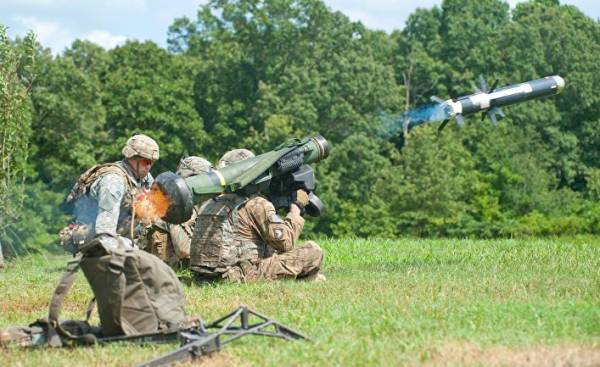
PRTK “javelin” is one of the most effective portable guns of the American armed forces. It is available to front-line infantry branches of the Navy and land forces, and mechanized infantry vehicles parts, usually stored in several pieces.
USA sold “Javelin” NATO countries, including France and Britain, allies in the middle East, such as Saudi Arabia and the United Arab Emirates, and countries in the Asia-Pacific region, including Australia, Indonesia and Taiwan.
Thanks to the ATRA, selling the “Javelin” is caused by political and military considerations.
Estonia and Lithuania, for example, bought from the United States 120 and 260 launchers, respectively. If the Baltic States were invaded by Russian tanks — the event is not very likely, but worrisome because small countries NATO will defend hard — armed “Javelin” infantry will serve mainly the front edge of the Baltic defense on land, until NATO mobilizes troops.
FGM-148 “javelin” American manufacturing is one of the best tank missile in the world. He also is an expensive piece of kit weapons, because each missile is typically more expensive than destroying its purpose.
Controlled infrared “javelin” has proven itself in combat operations in Iraq, Afghanistan and Syria, and has a feature that helps to cope with almost any tank — has its weak top armor. While the crew is exposed to less risk than in the case of a typical missile system. Thanks to its lightweight system may be the first element of the ground response in case of emergency “type of a massive, sudden tank attack” — scenario, which the U.S. military might face in the course of operation “desert Shield” when you deploy light infantry to protect Saudi Arabia, which currently fear in the Baltic States.
“Javelin” is so effective that the question of whom the United States sells or supplies, has repeatedly passed into the category of political. In addition to using the infantry squads, the US army will, apparently, set complexes “javelin” on vehicles.
How to throw these anti-tank “javelin” (and why are they so powerful?):
“Javelin” is not as streamlined and deadly as might follow from their name — they resemble bulky dumbbells just over a meter in length. But to blow up the tank, looks, fortunately, not important.
The command launcher unit (PBC) “Javelina” is equipped with a highly sensitive infrared sensor with multiple view modes, including four-time optical zoom, a thermal imager with a fourfold increase, and the scope of the limited engagement with twelve-zoom. The thermal imager and the missile seeker is able even to nine-fold increase. Therefore, PBC can serve as a portable scanning device for infantry. For the normal functioning of the imager “Javelina” must be fully cooled, which in theory is 30 seconds, but sometimes it may take more time, for example, if you were on the streets of Baghdad in the 50-degree heat. The system also includes several remedies to prevent or stop accidental start-up.
So as the PBC and the rocket together weigh about 23 kg, the launch can be made from the provisions of squatting or even sitting. This construction is much easier than driven-by-wire BGM-71 ТOW or other long-range missiles, which typically requires a heavy tripod. Marathon so will not run.
When the shooter finds the target, it captures the infrared seeker head and pulls the trigger, the missile “javelin” gently pushed out of the PBC without using the rocket engine, creating a relatively small nozzle wave. Besides the fact that the wave jet allows the enemy forces to easily identify the location of the launcher after firing in an enclosed space (e.g. building), it makes the run in mortal danger. Small wave “Javelina” is very convenient from the point of view of the life and health of the operator. Start in any case is accompanied by the emission of a certain quantity of gas, so to stand directly behind is not recommended.
After that, gunner, “Javelina,” should… in fact, it can even play games on the phone because, unlike most long-range anti-tank missiles “javelin” is a system based on the principle of “fire and forget” and does not require any further action after start-up. Operator “Javelina” is entitled to dive for cover and disguise, and is not obliged to remain in place to guide the missile to the target, as in the case of semi-automatic guidance system along the line of sight (SACLOS), such as driven-by-wire BGM-71 ТOW or AT-14 “Kornet” with the guidance of the laser beam.
After the shot, “javelin” second flies horizontally, then there is a launch of its rocket engine, and he rises up to 150 meters, which is called a curve shot. This is awesome — you can see by watching this video.
Infrared homing missiles, thanks to its gyros and swivel mechanism adjusts with rocket motors to ensure the verticality of the trajectory of the attack on the captured characteristic of the goal in the infrared range.
Released thus the missile “javelin” hit the top the protection of an armored vehicle, which in most cases is much thinner than the frontal or even side. 127 mm warhead cumulative “Javelin” penetrates estimated at 600-800 mm equivalent layer, rolled homogenous steel armor — not so much, given that modern tanks are covered effective against such armor warheads combined. But this is still more than enough to penetrate the top armor of anything, at least within this defensive system.
One of the most common elements of the defense, sometimes reinforcing the top armor, is the dynamic of anti shaped-charge armor protection, designed for inducing premature detonation of missile warheads.
“Javelin” is equipped with a tandem warhead, designed to defeat this type of armor with located in the front “leading” the charge. He breaks the protective layer and forms a hole through which the main warhead can hit normal armor of the tank.
“Javelin” can also be run in the mode of direct attack to engage targets that are too close to attack from above or under the cover of aircraft, such as a bunker or cave entrance. Fire mode to direct fire effective against flying at low altitude helicopters.
One of the few restrictions “Javelina” is a range of only 2.5 kilometers. Although most combat situations this is enough of the old missiles like ТOW or “cornet” can boast the ability to run at a distance of five kilometers or more.
Russia is also aware of the possibility of “Javelina”, and her newest tanks demonstrate some counter measures to combat them. New systems of dynamic protection “Relic” and “Mekhanit” have dual-layer triggered radar protective plates to defeat tandem warheads. Active protection system “Blind” and the latest “Afghani” can also use non-lethal multispectral grenades and flares to hide the tank from an infrared seeker or divert the latter to other sources of heat.
However, the ability of the latest infrared sensors to see through smoke and to distinguish extraneous flash from the original goal has also been improved. And the active protection system with the immediate objectives will have to learn to shoot vertically over the tank to cope with the attacker on top of “Javelin” to which the new system is “Afghani”, mounted on the turret of the T-14 and having located below the horizontal to the turret angle the launch tube did not seem able.
Work dynamic of anti shaped-charge armor protection like the “Relic” and infrared elements of defensive jamming against the “Javelin”? No way to know for sure just yet, unless Moscow suddenly not invited to Washington to participate in a kind of a friendly match to test the efficacy of anti-tank missiles of the United States against the best Russian tanks. But count on this is not necessary, because the relations between the two countries is too cold for US participation in the annual Russian tank biathlon.
So whether they work really?:
“Javelin” was developed in the 70-ies and 80-ies, when the US military command was tormented by nightmares about what they grab hordes of Soviet tanks — fear, aggravated while the generally low efficiency of missiles M47 Dragon.
“Javelin” entered service with the US army in 1996, after the end of the cold war, and used for the first time was in 2003 during the U.S. invasion of Iraq.
Due to the lack of possibility to send troops to Northern Iraq by land, the US special forces had landed, and they began to fight shoulder to shoulder with the Kurdish militias “Peshmerga”. In the battle for the pass Debeka a band of a few dozen commandos and a little more numerous contingent of Peshmerga destroyed an Iraqi mechanized company consisting of more than one hundred soldiers. The United States had only four launchers “javelin.” Was released 19 missiles, 17 of which hit the target, destroying two T-55, eight multi-purpose Transporter MT-LB and some trucks. Reportedly, all the shots from the complex “javelin” was produced at a distance of 2 200 metres or more — which was close to its official maximum range or exceeded it, and one of the hits was recorded at a height of 4,200 meters.
During the war in Iraq with the “Javelina” was destroyed a few not the most advanced tanks, including the Type 69 and T-72 “lion of Babylon”. At the end of the phase using conventional weapons anti-tank complex was used mostly for firing smaller and more vulnerable targets. High-precision guidance “Javelina” is ideally suited for detection and destruction from a distance heavy machinery insurgents equipped with machine guns, missiles or recoilless grenade launchers, and pickup trucks. Other available infantry weapons set range and accuracy, not possessed.
The paradox of using the complex “javelin” in order to destroy the pickup trucks and machine guns is that the cost of these missiles is over 80,000, which is much higher than the cost of destroyed weapons systems. According to reports, this led to the fact that in Afghanistan, the United States often refrained from using this weapon. Although it is considered “easier” are installed on the combat vehicle anti-tank TOW missiles, since 2003 the latter was much more involved.
However, given the fact that the US spend tens and even hundreds of thousands of dollars to ensure the functioning of expensive jet fighters or deploying a large number of ground troops to destroy a few fighters at a time, the relative cost of the use of missile system “javelin” as a heavy sniper weapon may not be so absurd. In this case, it is likely to cause less collateral damage than artillery or shock bombs with laser guidance. And if this impact is timely and addresses an active threat, exposing allied troops at risk, you can save a lot of lives.
Last warning when evaluating complex “javelin”: it may is a high level anti-tank weapon, it has never been used against modern tanks, you can not say about missile systems TOW and Kornet.
The Future Of “The Javelin”:
Antitank missile system “javelin” has undergone many upgrades since the initial combat use in 1996 — let’s look at three most important ones.
Given that the “javelin” was used primarily to attack vulnerable targets, introduced a new, more lethal high-explosive modification of its warheads, dubbed FGM-148F. Compared with their predecessors, presumably, less effective against tanks and are not expensive in price.
The US army has also funded the development of lightweight block sighting and launcher equipment. As planned, the new system launch is 70% smaller and twice lighter in weight, and the updates will include an upgraded electronics, a new laser designator, a color camera with high definition and infrared sensors with improved range and resolution.
And finally, it was recently tested a new “javelin” extended range, capable of hitting targets at a distance of 4.5 kilometers. This is important since one of the main arguments in favor of using the missile system TOW as the standard anti-tank weapons mounted on military vehicles, was a range of almost 5 kilometers. “Javelin” long-range his, apparently, surpass.
Installed on military vehicles, missile systems “javelin” is now under preparation. In 1990-ies America, reportedly experimented with crawler platforms “Bradley” to transport “Javelin”, but the project was not carried out. However, recently it was announced the intention to upgrade for this purpose half of the armoured fighting vehicles of the Stryker family. (The other half will be equipped with 30-millimeter automatic guns). Only specialized Strykers M1134 equipped with TOW launchers and was able to counter any tanks.
The transition to the medium-duty vehicle armoured personnel carriers for effective anti-tank missiles equivalent to installing Russia’s deadly anti-tank missiles “cornet” in armored turrets “Epoch” latest BTR “boomerang”, “Kurganets” and T-15 “Armata” (not to be confused with the T-14).
Compared with the TOW missiles, the complex “javelin” would be a more flexible weapon, as its carrier rocket is able to leave the danger area immediately after launch. If the upgrade still occur, even light armored vehicles the U.S. receive anti-tank firepower and the ability to launch precision-guided missiles.
An interesting question arises: what will happen with TOW missiles, which are considered more powerful and is assigned to specialized anti-tank platoons? New TOW-2B Aero has a kinetic warhead with a wireless guidance system for hitting targets from above, making the launcher is not tied to the rocket, a mobile operator, although guidance on the purpose of his presence in any way necessary.
Although the TOW may have lost its advantage, in terms of range, it is controlled by optical, rather than using infrared radiation, and is less than about 59 000 dollars. The U.S. military thus could leave armed with both systems and to cope with virtually any interference or interventions, but less costly, a long-range missile save for fighting with militants in Afghanistan and Iraq.
Political arena:
PRTK “javelin” is one of the most effective portable guns of the American armed forces. It is available to front-line infantry branches of the Navy and land forces, and mechanized infantry vehicles parts, usually stored in several pieces.
USA sold “Javelin” as the NATO countries, including France and Britain, allies in the middle East, such as Saudi Arabia and the United Arab Emirates and countries in the Asia-Pacific region, including Australia, Indonesia and Taiwan.
Thanks to the ATRA, selling the “Javelin” is caused by political and military considerations.
Estonia and Lithuania, for example, bought from the United States 120 and 260 launchers, respectively. If the Baltic States were invaded by Russian tanks — the event is not very likely, but worrisome because small countries NATO will defend hard — armed “Javelin” infantry will serve mainly the front edge of the Baltic defense on land, until NATO mobilizes troops.
When Russia provided military support to the separatists in Ukraine, columns of Russian tanks contributed to the interruption of offensive operations of the Ukrainian army and capture the strongholds of the government, in particular the Donetsk international airport in January 2015. Hawks like Senator John McCain, insisted on the provision of assistance to Ukraine, called the “javelin” the key weapon system that could change the fate of the Ukrainian army on the battlefield and would be much more practical to use than the battle tank or jet fighter.
However, delivery of U.S. missiles to other countries has exacerbated the conflict between the US and Russia. In contrast to the widely exported TOW missiles or various systems of Russian weapons, the Ukrainians without permission of the United States, such weapons could not. That is, “javelin” Ukraine is not supplied.
In theory, this kind of policy is also applicable to various Syrian militant groups, weapons which put the US including Kurdish groups opposed to Turkey. The United States recognized the fact of supplying them with TOW missiles early sample, but not the “Javelin”.
But then the following picture emerges.
In February this year was seen as Kurdish forces near El-Shaddi fired “Javelina”, destroying trucks with improvised explosive devices, which were sent to their positions. You can see this here.
The report about the presence of the Kurds “Javelina” caused a great resonance, although the US government insists that the relation to this has. Maybe it was hypocrisy or “javelin” belonged to those who fought side by side with a Kurdish special forces unit of the United States and was intended for a specific purpose, not being a part of a systematic program. According to another hypothesis, “javelin” sent one of supporting the militants of the middle East countries.
This year, the Turkish army lost nearly a dozen tanks, “Patton” due to strikes anti-tank missiles available to confront them Kurdish fighters and ISIS militants. However, it is still unknown whether it was missiles “javelin”.
“Javelin”, in any event, it remains one of the most powerful land weapons systems in the USA which, apparently, is ready to build capacity and to be part of a growing number of programs. The presence of such weapons or waived in military conflicts around the world remains an important issue and the object of careful study.







